Examples of Past Projects
 Heritage Tree Retention with New Road Over Roots
Heritage Tree Retention with New Road Over Roots
A Dawn Redwood was identified as a heritage tree at the Woodlands site in New Westminster. As redevelopment of this site proceeded it became clear that the new road alignment would have to meet many criteria and could not be moved to save the tree. It would cover about 45% of the roots and be 1.5 metres higher than the existing grades. The challenge became how to accommodate the new road alignment and successfully retain the tree.
Working with the client, engineers, planners and municipal staff we proposed a floating beam that would sit just above the existing grade and span right over the critical root zone of the tree. This beam would carry the new sidewalk and road to a second wall built at the outer edge of the critical root zone.
The design accommodated the twin goals of road development and tree retention. After extensive review with the engineers an acceptable design was drawn up and approved by City staff.
We supervised each stage of the construction to ensure that the tree was properly protected, and soil and root disturbances were minimized. More than a decade later the tree is still thriving with no loss of health. It is a feature in the new landscape.
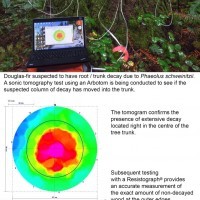 Advanced Tree Risk Assessment
Advanced Tree Risk Assessment
Working with an Arbotom and a Resistograph® we regularly inspect trees for decay. The first step is to visually assess the tree and decide if advanced tests are required. In some cases the presence of fungal fruiting bodies provides preliminary clues about what might be happening inside. Step 2 is to decide where the best place would be to test for decay. Step 3 is to conduct the tests, examine the results and see if additional tests might be required. Step 4 is to analyze the data, prepare a written report, and make recommendations to the client about what was found, along with options for management.
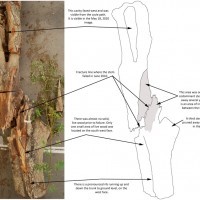 Forensic Investigation of Tree Failure
Forensic Investigation of Tree Failure
As part of the investigation necessary for an inquest in Hong Kong we visited the accident site and spent several days examining the fallen tree. By carefully piecing together the tree parts we were able to reconstruct the tree as it would have looked prior to failure. That information was then used along with other evidence to provide additional information about cause of failure.
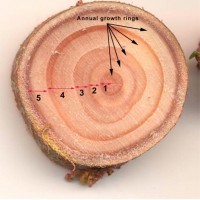 Forensic Investigation about Alleged Tree Pruning
Forensic Investigation about Alleged Tree Pruning
A client was accused of illegally pruning trees on an adjacent property. The client noted that the work had been undertaken with permission about five ago. The neighbour was adamant that it was only two years ago, right after they had purchased their property. By taking samples of new limb growth, we were able to conclusively show that there were indeed five years of growth. The case did not proceed to court.
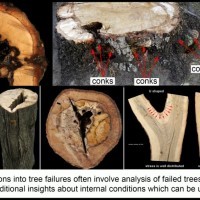 Tree Failure Investigations
Tree Failure Investigations
Often tree failures cause accidents or property damage. Part of the investigations involves analysis as to whether or not the tree would have been assessed as a high risk before failure. We have extensive experience in failure analysis, dissecting and investigating each component. The results not only help the immediate case, but are also useful in helping to understand risk assessments in the future.
 Best Management Practices
Best Management Practices
Often the simplest way to document desired treatments and approaches is to prepare a comprehensive report laying them all out systematically. In this example, the heritage trees at the Riverview site in Coquitlam (the first arboretum in the province), were inventoried and assessed. A series of management guidelines were then assembled to serve as a foundation for future work in and around the trees.
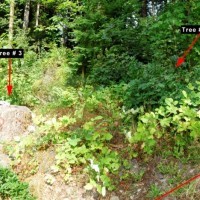 Illegal Cutting, Trespass, Damage Valuations
Illegal Cutting, Trespass, Damage Valuations
Trees are often removed from an adjoining property without permission. We investigate the site, document the evidence clearly, and prepare detailed reports about the values of the lost trees, and costs of restoration. Most such cases usually settle out of court. Part of the process is the preparation of good graphics to illustrate the site conditions clearly.
 New Driveway for Homeowner
New Driveway for Homeowner
The client wished to develop a new driveway to the house. The proposed alignment traversed a slope in among several arbutus trees, which were scheduled for retention. The challenge was to design the driveway to meet engineering requirements for slope and structural integrity, while at the same time avoiding damage to the tree roots and minimizing changes in soil hydrology. The approving Municipality had expressed concern that the road could not be built without damage to bylaw sized trees to be retained. Working with the client, and utilizing the survey plans and engineering drawings, we designed an alternative alignment that maximized the offsets between trees to be retained. We provided a range of engineering options for designs that would minimize the amount of excavation required beyond the road surface, so that root damage and soil moisture changes were minimized. The final design was approved for construction. We supervised the layout, tree protection fencing, excavation and root pruning, to ensure that the design was implemented correctly. The end result satisfied all Municipal, engineering and client requirements.
 Sun Angle Analysis
Sun Angle Analysis
New buildings, tall trees, and high hedges can be problematic. By using solar chart analysis tied to an exact latitude and longitude we determine the extent of the shading problem by season and time of day. We can then suggest approaches to deal with the issues.
 Assessing Flood Damage
Assessing Flood Damage
A rural landowner was having flooding problems due to a raised culvert on an adjacent property. The raised water table was killing trees on his property. We documented past and present vegetation conditions, identified dead trees by location and elevation, and examined growth patterns between live and dead trees to demonstrate the year in which tree problems started – it proved to correlate exactly with the change in drainage patterns.
Tree Fatality Data
Since 2007 Dunster & Associates has been collecting comprehensive data about the number of people injured or killed by falling trees, or tree branches. We maintain what may well be the largest data base in the world dealing with this topic. Using Google Alerts we have documented data from all over the world where the ‘person on the street’ (as opposed to workers dealing directly with trees) have been killed or injured by trees. The data can be categorized as injuries or fatalities caused by a falling limb or whole tree failure. The results provide order of magnitude estimates about the frequency and severity of these events. We also have data about the dollar value of settlements. Analyzing the data we are able to derive some information about the cause of failure, such as dead trees, rotten or rotting trees, and decay patterns. We can also look at damage type such as vehicles, and buildings, as well as the geographic areas where failures have occurred, and the weather patterns associated with the incidents.
For more information please call us.
Trees and the Law – Court cases
In the process of writing Arboriculture and the Law in Canada Dunster & Associates initiated a data base of tree cases across Canada and the United States. We are constantly updating our collection. If you would like more information, or if you have a case of interest to add to our collection, please call us.
